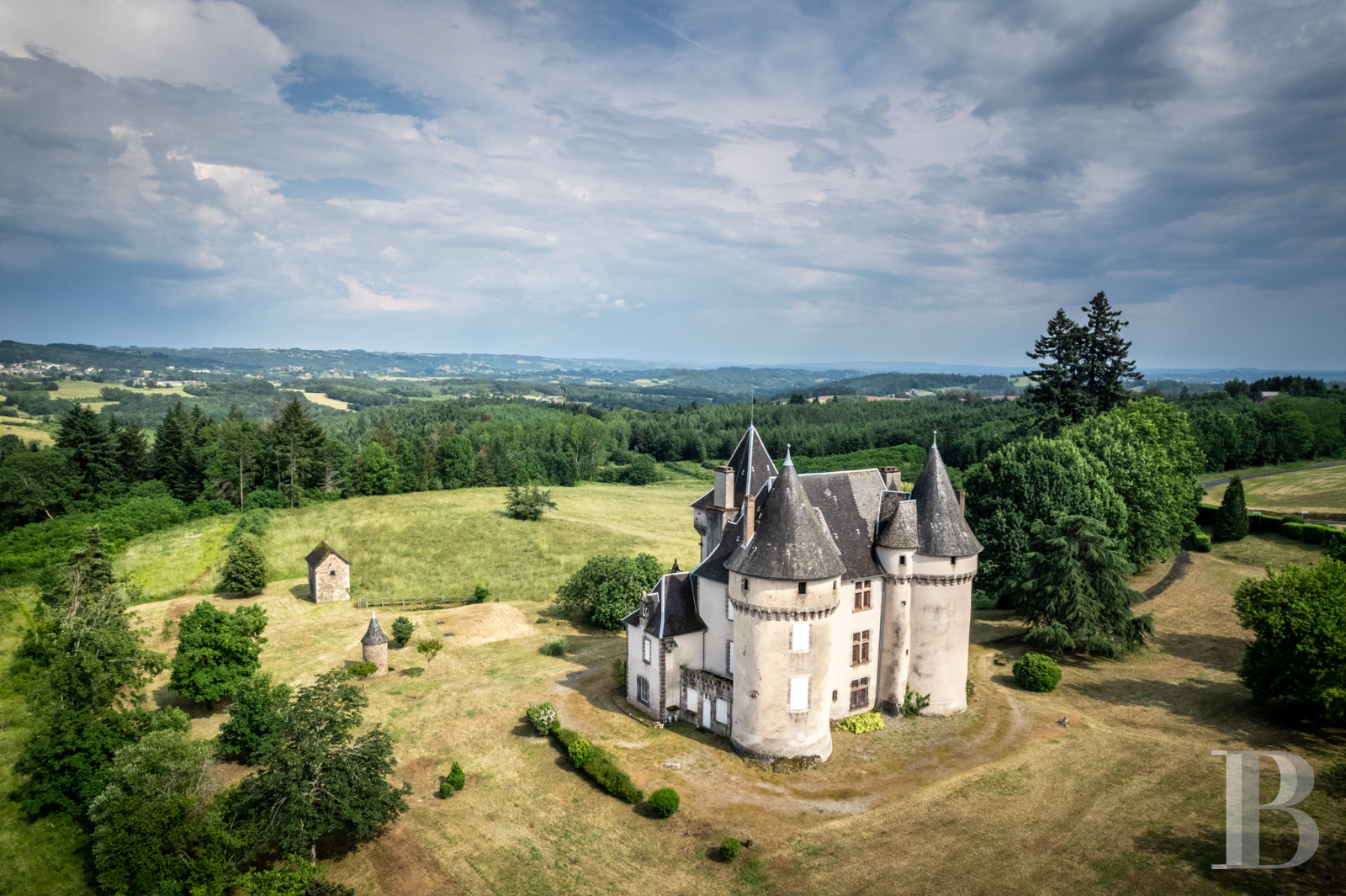
For Sale: A French Chateau (Weekend Retreat)?
Corrèze, France —Listed for €690,000 (approx. $755,000 US)
So, something a little different (and well outside if my determined commuting tolerance). Something I would not have initially considered, but ….. how about a 15th-century castle which comes with its own hamlet of outbuildings on a panoramic and private 15-acre property in the Corrèze region of France, a convenient 30-minute drive from the picturesque town of Brive-la-Gaillarde (or 5 hours from Paris). If you’re like me and have ever been to Europe, you can easily see yourself living there – not only the windswept countryside, the weathered historic architecture and (lets be honest) the food, but for the chance to actually live in one of these fairytale castles!
Those of you who have read my bio (what am I saying, of course you all read my bio!). Let me rephrase this – having read my bio, you would know of my whackadoodle crazy obsession with architecture, pretty much any architecture (except the bad shit of course). Growing up, I stumbled across a British magazine at our local mall bookstore called “Country Life”, which appears to now only be available on line – https://www.countrylife.co.uk/property-home. In this wonderful publication (God I miss magazines) I found they devoted about half of their pages to real estate – not just any real estate, but ancient piles of stones with such pedigree and history as could have only been experienced in old black and white movies (generally historical Jane Austin type period pieces (think 1940’s “Pride and Prejudice”) or gothic horrors (think 1963’s “The Haunting”) – then of course there’s the house in 1975’s “The Rocky Horror Picture Show”, but I digress.
That brings us to this sweet little gem…
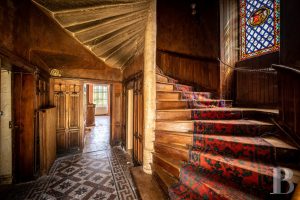 Picture this as a romantic vision – you leave the charming historic town center, following a charming stone walled country lane which leads to the main entrance of the property. (I made up the stone lined part, but the lane SHOULD be lined with stone walls!) Passing through the entrance gates, you follow the driveway as it winds gradually through the somewhat overgrown landscaped grounds, terminating at the romantic medieval pile standing proudly at the center of a largely grassed, rectangular plateau.
Picture this as a romantic vision – you leave the charming historic town center, following a charming stone walled country lane which leads to the main entrance of the property. (I made up the stone lined part, but the lane SHOULD be lined with stone walls!) Passing through the entrance gates, you follow the driveway as it winds gradually through the somewhat overgrown landscaped grounds, terminating at the romantic medieval pile standing proudly at the center of a largely grassed, rectangular plateau.
The four-story castle, or maybe more appropriately called, “chateau”, itself is a collage of round towers, turrets, machicolated parapets, molded corbels, carved coats of arms (of the original Earls family) and mullioned windows (from which to launch arrows at uninvited guests). All neatly encased in pointed limestone, granite and sandstone and capped neatly off with a chestnut shingled and slate tiled roof.
The mostly original, and partly restored interior is accessed through the chateau’s central square tower. Pushing open the massive studded oak door, you cross the stone threshold into your own personal Camelot – a virtual treasure chest of architectural history. Upon entering, you find yourself facing s large spiral staircase leading to the upper floors. This staircase is uniquely paneled in 1850 woodwork and provides formal access to the 3 upper floors.
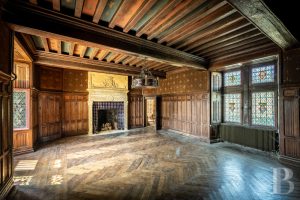 The main, entrance level contains a grand reception room with large stone fireplace and, according to the listing, “Versailles” parquet flooring, which I Googled and learned that it’s basically parquet flooring, but REALLY nice parquet flooring made of an intricate pattern of different types of wood laid in an “X” pattern; and, “French beamed ceilings” (again, per the listing). Googling this resulted in just, well … beamed ceilings – which I guess were ceilings installed by people with an accent. Adjacent to this room is a second sitting room, not as grand as the reception room, finished with Gothic paneling and (yes, per the listing) a “Grand Siècle style alcove”, which is apparently an ancient reading nook. There’s also a labyrinth of additional rooms on the first couple of floors including: a library, with painted ceilings, and something called “napkin pleat” wood paneling; a dining room with a “monumental” fireplace, herringbone parquet flooring, stained-glass windows and more “napkin pleat” paneling; and an original multi roomed kitchen complex.
The main, entrance level contains a grand reception room with large stone fireplace and, according to the listing, “Versailles” parquet flooring, which I Googled and learned that it’s basically parquet flooring, but REALLY nice parquet flooring made of an intricate pattern of different types of wood laid in an “X” pattern; and, “French beamed ceilings” (again, per the listing). Googling this resulted in just, well … beamed ceilings – which I guess were ceilings installed by people with an accent. Adjacent to this room is a second sitting room, not as grand as the reception room, finished with Gothic paneling and (yes, per the listing) a “Grand Siècle style alcove”, which is apparently an ancient reading nook. There’s also a labyrinth of additional rooms on the first couple of floors including: a library, with painted ceilings, and something called “napkin pleat” wood paneling; a dining room with a “monumental” fireplace, herringbone parquet flooring, stained-glass windows and more “napkin pleat” paneling; and an original multi roomed kitchen complex.
This compartmentalized kitchen is in dire need of refurbishment and presently stands as a substantial empty space on the lower floor. The main room of this service complex, is a vast terracotta tilled space, centered around a granite inglenook fireplace, from which a delicious labyrinth of prep spaces, larders, sculleries, pantries, and cellars branch off. I can just imagine the amazing design opportunities that could be realized in this space in the creation of a working/ functional kitchen within the stone arched ceiling, earthenware flooring and original, gothic windows. Maybe a pantry concealed by a secret panel or cupboard which slides open to reveal this hidden surprise. A small, obscured door leads to a stair descending to a vault ceilinged cellar network below the kitchen space – another delicious creative opportunity awaits – speakeasy perhaps?
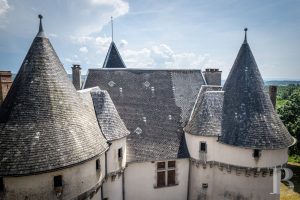 The upper levels comprise four owners’ bedrooms with chestnut parquet flooring and four generously proportioned former servants’ bedrooms tucked into the ceiling below the highest level which contains the attic. This attic, accessed by a small stone staircase, contains a dizzying set of walkways which meander between the complex towered and gabled roofline supported by five-hundred-year-old beams and timbers.
The upper levels comprise four owners’ bedrooms with chestnut parquet flooring and four generously proportioned former servants’ bedrooms tucked into the ceiling below the highest level which contains the attic. This attic, accessed by a small stone staircase, contains a dizzying set of walkways which meander between the complex towered and gabled roofline supported by five-hundred-year-old beams and timbers.
Beyond the main house, the property comes with its own authentic medieval village, well maybe not quite medieval, as these structures were added in the 19th century, but medieval(ish). I don’t know what it is, but I’ve always loved the nooks, the crannies, courtyards and the romantic vision of the complex of accessory buildings of an historic property. Ah, the purpose-built structures, originally created for the housing of staff, livestock, horses, tack, feed, and various greenhouse and other estate activities. I, for some reason, find it all very romantic and appealing. Even though in the age of “just in time” deliveries and pared down “servant-less” living, these complexes are not actually a necessity these days.
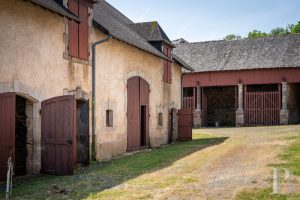 Apparently, the structures on this estate had been added in the mid 1800’s in an effort to “modernize” the primitive attic servants’ quarters, and random other estate support needs, without detracting from the authenticity of the existing medieval style of the main house. They are all of a pared down scale from the main building, but constructed with complementary slate roofs, exposed and pointed stone walls and dressed stone window frames, which make for a striking architectural uniformity. Aside from the village, there are two additional three-room dwellings, a separate, stone farmhouse complex with its own column fronted barn with hayloft, garage, stables and something called a “cowshed”. Beyond the main complex, and at the western most end of the property, there is also a winery complex which dates from the time of the chateau’s original construction. Many of these support structures are partially restored, while others are in dire need of some love.
Apparently, the structures on this estate had been added in the mid 1800’s in an effort to “modernize” the primitive attic servants’ quarters, and random other estate support needs, without detracting from the authenticity of the existing medieval style of the main house. They are all of a pared down scale from the main building, but constructed with complementary slate roofs, exposed and pointed stone walls and dressed stone window frames, which make for a striking architectural uniformity. Aside from the village, there are two additional three-room dwellings, a separate, stone farmhouse complex with its own column fronted barn with hayloft, garage, stables and something called a “cowshed”. Beyond the main complex, and at the western most end of the property, there is also a winery complex which dates from the time of the chateau’s original construction. Many of these support structures are partially restored, while others are in dire need of some love.
On an interesting side note, when you do a Google search on castles/ chateaus available for sale in Britain and France, it is surprising how many similar and affordable properties pop up. A longer commute, may warrant some real consideration!
Photos courtesy of Patrice Besse Real Estate Services.
To see the full listing of this property, and many more like it, click here.